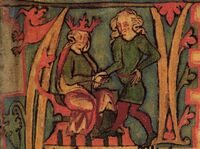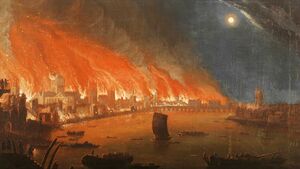Andesen of Flatstone
King Bjarn Von Stone | |
|---|---|
 Illustration of Bjarn Von Stone supposedly in the Szlād Imperial Palace. | |
| Native name | Şotī Bjājn |
| Birth name | Bjarn Von Stone |
| Born | 16th June 1194 Suntugā, Flatstone |
| Died | 23rd August 1237 Vedotī, Flatstone |
| Buried | Suntugā, Flatstone |
| Allegiance | |
| Rank | Commander in Chief |
| Battles/wars |
|
| Spouse(s) | Edna Von Stone |
| Children | Eirik Von Stone |
| Relations | Northern Ivili Clan |
Bjarn Von Stone was born just one year before the ceasefire. He had been born into an isolated farmhouse somewhere in Suntugā, supposedly growing up with his mother and potentially his father, although it should be noted that his mother was believed to have been widowed. Not a lot is known about Bjarn's childhood and his progression into adulthood, but what is certain is that Von Stone was a name that he gave to himself, and his original last name is unknown. It is likely that Bjarn taught himself archery and swordsmanship at a young age, as by the time the First Stonish War of Unification broke out in 1211 his performance in battle and leadership was reportedly "excellent". Bjarn left for the capital of Vedotī at age fourteen in order to find work and make money, however rather then starting a farm of his own or participating as an architect, Bjarn would be quick to find his way into the politics of Northern Ivili, establishing himself as the self-proclaimed successor of Erik Slaten at the age of 17 and taking after his beliefs and accomplishments, using religion as a tool to seize and maintain power through authoritarian means. By the time he was 18, the civil war was in full swing and Bjarn had couped the remnants of Northern Ivili in the same fashion as Erik Slaten had a century prior.
Early Life
The circumstances in which Bjarn Von Stone were born into were not exactly ideal. He had been brought into a world during a period in which the very land that he resided in was in a constant state of war with all of it's neighbors, a time when the nation had only recently begun it's transition from theocratic governance being the standard to several culturally divided kingdoms that divided up the archipelago through conquest and division, ultimately resulting in the deaths of thousands. Bjarn Von Stone was well aware of these atrocities, and it is only natural that early in his life he developed a want to put an end to the chaos. A desire to bring peace and national unity to the peoples of the archipelago.
Parents and Childhood
It is very unlikely that Bjarn Von Stones parents were anybody of note; having been born and raised in the capital of the Taverkny Clan, Bjarn Von Stone was the first and last king of Taverkny ethnicity. However, Bjarn Von Stone did not embrace his Taverkny identity during his lifetime, and instead gradually developing a liking for the Northern Ivili clan after having lived in the Northern Ivili capital of Vedotī for extended periods of time. There is little of note that is known about Bjarn Von Stones parents, all that can be said for sure is that they were not particularly wealthy and were unusually fair for the time when it came to the treatment of their children, of which they had three. The whereabouts of Bjarn Von Stones siblings are unknown, as Bjarn Von Stone would erase his Taverkny identity, and with it his past, in favor of the name "Bjarn Von Stone," a name that he would give himself after his journey to Vedotī at the age of seventeen.
Early Interest in Military Strategy and Politics
Much like his predecessor, Erik Slaten, Bjarn Von Stone had a particular liking for military strategy and politics. Ultimately, he aspired to acquire a position of power, whether this was peacefully or by force did not matter to him. Bjarn thought highly of himself, he wholeheartedly believed that he out of all people had what it took to lead the nation to a better era. However, unlike Erik Slaten, Bjarn Von Stone did not devote a large amount of his time to his studies. He went into the world with far less experience and not much of a plan. The one thing that Bjarn Von Stone had was ambition, and ambition was the fuel that propelled him into the future. He was naturally charismatic, and was very lenient when it came to positions of power. He was willing to listen, and he never underestimated the advice of his peers. These traits gave him a natural advantage over his competitors, and by the time that he was twenty he had already amassed a large following capable of undermining those already in power through a brutal coup d'état that would cost the lives of dozens. It would go to show just how far Bjarn Von Stone was willing to go to achieve his ambitions.
Political Career
Rise to Power
Bjarn Von Stone would arrive in the city of Vedotī at the age of seventeen after having fled from his parents land in order to pursue an ambition to participate in the ongoing conflict between the Northern Ivili clan in the north and the less influential Taverkny clan to the south. Bjarn did not trust the abilities of the Taverkny clan, nor did he believe that he would be able to obtain a position in any of it's armies. The Taverkny clan was largely hereditary, meaning that most of it's authority was controlled by those who were born into positions of power. Bjarn Von Stone was not, and so it was unlikely that he would make any progress towards his goal, having virtually no claim to anything of significance throughout the Taverkny clan. Instead, he opted to travel to the Northern Ivili clan, where, coincidentally, a shortage of officers had begun to plague the Northern Ivili army and it's competency. Bjarn Von Stones natural skillset and leadership made him a prime candidate for a position as an officer, which he would assume and use to his advantage.
House of Von Stone
In order to strengthen his legitimacy, Bjarn Von Stone would finalize the decision to change his name to Von Stone shortly before joining the Northern Ivili army with the intention that he'd use the name (which was derived from Geology) to begin his own dynasty, which would then rule his future kingdom. This, and the fact that Von Stone was a more suitable name for an officer in the Northern Ivili army at the time. The House of Von Stone would not be officially created until 1231, after Bjarn's victory in Suntugā bay against the fleet of the Taverkny clan, when he married his wife, Edna, who would later become the first queen of Flatstone after the nations unification in 1232. Today, the House of Von Stone continues to rule the Kingdom of Flatstone, having returned after the removal of the republican government in 2008. However, this would only be after a period of roughly fifty years, when the nation was ruled democratically under the previously mentioned republican government that seized power in the 1960's after a brutal revolution against corrupt officials that had ties to the House of Von Stone.
Ties to Geology
Bjarn Von Stone was well aware of Geology and it's widespread following throughout the nation of Flatstone. It was likely even before his rise of power that he would realize it's potential, it's uses, and most importantly, it's advantages. By the time that Bjarn Von Stone had earned himself a position in the army of the mighty Northern Ivili clan, Bjarn Von Stone already had plans to model his future empire off of the religion. Bjarn Von Stone himself would end up converting to the religion at the age of twenty following two years of service in the Northern Ivili plan in accordance with his ambitions. He would even go as far as to lead a micro-campaign amongst the ranks of the Northern Ivili army (or more specifically his close friends and peers) in order to spread the faith to those that were close to him. Many of those who willingly converted to his faith would later receive positions of authority within the unified Kingdom of Flatstone in the 1230's.
Northern Ivili Coup D'etat
In 1215, at the age of 21, Bjarn Von Stone had finished his initial preparations for his planned takeover of the Northern Ivili clan. He had amassed a politically-loyal following through his charismatic character and endorsement of the Geologist faith. In February, Bjarn Von Stone, accompanied by a party of roughly 24, would lead a march on the Northern Ivili capital city of Vedotī, participating in religious demonstrations and delivering speeches for the cities locals to hear. This was done repeatedly for roughly two months until Bjarn's activity throughout the city ceased after a citation was issued to him by his superiors, claiming that his actions and participation in the ruckus was stirring unrest and treason towards the state. However, by this point, Bjarn Von Stone was in control of a fairly large portion of the Northern Ivili army that had gradually become more and more politically loyal to the future king, meaning that any attempt at a forced removal of the decorated officer would result in civil war. Instead, it was decided that nothing would be done about Bjarn Von Stone, and that he would be "surveyed" by his superiors for the months to come. This, however, would never happen. As in June of 1215, Bjarn Von Stone would challenge another decorated officer in the Northern Ivili army that had openly announced his opposition to the growing following of Bjarn Von stone to a duel. Bjarn Von Stone would inevitably win this duel, resulting the death of the opposing officer and the decline of his opposing faction. Bjarn Von Stone would then make his way to the royal courthouse of the Northern Ivili clan in the city of Vedotī in order to confront the head of the clan before the ruling class even had an opportunity to hear about the death of a Northern Ivili officer. Bjarn Von Stone would storm the courthouse, accompanied by a faction of roughly two-hundred, who would surround the courthouse preventing the escape of any of it's occupants. Bjarn Von Stone would trial the leaders of the Northern Ivili clan in their own courthouse, having all of them executed and instating himself as the new head of the clan. Bjarn Von Stone would initiate war against the rest of Flatstone just one year later.
Military Career and Campaigns
First Stonish War of Unification
Victory in Suntugā Bay
Despite a string of victories against coalition troops garrisoning vital ports lining the archipelagos coast, the last Posukoşoti would be expelled from the south, where they had occupied land during their coastal terrorization campaign, when the twenty-day long occupation of Īnbā in Ou territory came to an end. Bjarn and his fleet embarked from Īnbā, temporarily docking in occupied Southern-Ivili territory in order to assist a defensive headed by Gert Koch, a noble that had been tasked with defending three vital ports in the south, all of which were crucial for maintaining naval supremacy in the south. Gert Koch's defensive would ultimately be successful, allowing for Bjarn to maintain his spree as he had planned. This time, it was decided that the Taverkny capital of Suntugā would be seized, theoretically making for an easier target, being on a sparsely populated island off the coast of Poşotī that lacked any proper defense. However, the Taverkny had managed to maintain the presence of it's navy in the Suntugā Bay, likely because of the threat that the norths fleet poised on their vulnerable capital. However, at this point in the war, resistance by the Taverkny and their allies was practically futile. The majority of the archipelagos populace was in favor of reunification, this is likely because the only time that the nation had seen peace and prosperity was when it was unified under Erik Slaten. Although, Erik's theocratic government had been flawed in more ways than one. When Bjarn's fleet arrived in the south of the Suntugā Bay, they discovered that over two dozen Taverkny ships were actively engaging with each other. Bjarn, confused as to how he was supposed to approach the situation, would come to realize that the Taverkny fleet had degraded into a state of civil war, divided between those who were attempting to maintain control and those who were trying to defect to the north (in support of reunification). Bjarn's comparatively larger fleet intervened in the affair, swiftly crushing those who were attempting to divert the mutiny. The majority of the Taverkny fleet was incorporated into that of Bjarn's, as well as it's crew. Fewer then five vessels would manage to escape the encounter, all of which likely returned to the port in Suntugā. Despite this, their safety would be short-lived, as immediately after this, Bjarn landed on the easternmost coast of the island, pillaging three different fishing villages and robbing their residents of their reserves and valuables. From there, Bjarn would march approximately twenty-one kilometers to Suntugā itself, briefly laying siege to the city before it's inner-garrison surrendered itself to Bjarn, with the city welcoming him and the Posukoşoti with open arms. Shortly after the fall of the city, the Southern Ivili, no longer able to bear the losses sustained after the capture of it's trade-rich southern coast by the north, seceded to the North and was incorporated, being granted vassal-status until the end of the war when it would be annexed into the greater "Kingdom of Flatstone", proposed by Bjarn for hypothetical reunification. In 1231, Taverkny would agree to cede it's territory and the remainder of it's fleet to the north, officially putting an end to the war in Poşotī.
Anti-Ou Sentiments
Second Stonish War of Unification
Invasion of the Ou Clan
The Kingdom of Flatstone had little time for economic recovery and political reintegration of the archipelago that it did control. The young nation was thrown into war once again almost immediately, this time with an enemy that was much more navally capable that it's predecessors. Despite this, the Kingdom of Flatstone held a number of advantages over the measly Ou Clan, one of which being Stonish control over the northern Kosīdosugā islands, which had served as the foundation for Ou naval and trade dominance in the south of the Stonish archipelago. However, due to the fact that the northern Kosīdosugā islands were surrendered to the Kingdom of Flatstone, subsequently resulting in an influx of Ou immigrants fleeing the islands to avoid execution, imprisonment, or the harsh taxes into the southern Kosīdosugā islands, where the Ou capital was located. This caused confusion within the Ou navy, forcing it to remain in port for three months after the date that it had been expected to depart on, as well as slowing the mobilization of an Ou army, that had been disbanded after the end of the first war of unification. This gave the armies and navies of Flatstone time, valuable time that it needed to prepare.
Capture of Port Kumonlān
In November of 1232, the Stonish Fleet arrived at Port Kumonlān, situated on the coastal outskirts of the Ou capital in Kumonlān. There, the Stonish made a crucial realization, this realization being that the Ou were not as prepared for war as Stonish nobles had expected them to be. When the Stonish fleet arrived in Kumonlān, they found Port Kumonlān to be a mess of merchant ships struggling to maintain the flow of traffic throughout and around the port as hundreds of locals attempted to navigate through the mess of scattered, foreign vessels that littered the ports' waters like discarded plastic. In response, the Stonish admirals did what any ambitious officer would do when given an opportunity such as this one; Fire. The decision was made to set fire to the hundreds of merchant ships clogging the port, looting, pillaging, and murdering their owners as the Stonish navy went from ship-to-ship, setting fire to anything that was thought to catch fire. The Stonish Navy lost a small amount of their own vessels in this process. However, in doing so, the largest portion of the Ou fleet was trapped in-port. This turned the battle at Port Kumonlān from a naval engagement into a ground battle, with the Posukoşoti arriving shortly after. At this point, the Ou military garrison at Port Kumonlān hadn't even caught on to the arrival of the Stonish navy at the port, as they had been so busy attempting to manage the influx of Ou immigrants from the northern Kosīdosugā and controlling the fire that they had assumed was caused by the immigrants. This lack of miscommunication caught them off guard, as they were slowly picked off one-by-one by the Posukoşoti, who were now pouring into the city, taking the heads of Ou officers, magistrates and anybody who resisted. The Ou fleet fell into the hands of the Posukoşoti after it's crew had failed to resist the Posukoşoti horde, resorting to suicide in order to avoid capture or execution. Bjarn Von Stone would arrive in the city to oversee it's capture shortly after this, and the remainder of the city would fall into the hands of the Kingdom of Flatstone.

